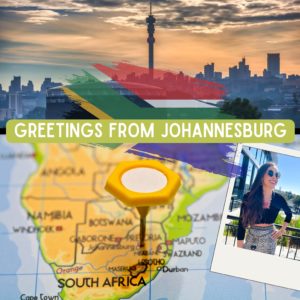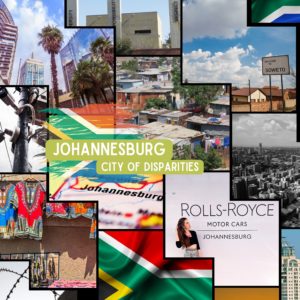
Greetings from Johannesburg, where I spent some amazing days. South Africa’s largest city and financial hub presents a complex tapestry of contrasts. It’s known for its stark disparities, where opulent neighborhoods and extreme wealth coexist alongside significant poverty and crime.
 Outside of my hotel in Melrose Arch.
Outside of my hotel in Melrose Arch.
Johannesburg has a reputation for high crime rates, particularly in certain areas. As a result, security measures are pronounced such as armoured cars and security services. My hotel was in Melrose Arch, which is renowned for its world-class safety due to fences and security gates. Many homes in affluent areas are surrounded by high fences, electric gates, and security cameras. Private security firms patrol these neighborhoods regularly.

Despite the security concerns, Johannesburg is also a city of considerable affluence: It’s not uncommon to see high-end cars like Rolls-Royces, Ferraris, and Bentleys on the streets, especially in wealthy suburbs like Sandton and Houghton. The city also boasts numerous luxury shopping malls, upscale restaurants, and exclusive boutiques, catering to the affluent population.
 Nelson Mandela Square is linked to Sandton City shopping center and is one of the most fashionable destinations in Johannesburg.
Nelson Mandela Square is linked to Sandton City shopping center and is one of the most fashionable destinations in Johannesburg.
This juxtaposition of wealth and security highlights the broader socio-economic inequalities. Many residents live in townships and informal settlements, where poverty is rampant, and access to basic services can be limited. However, Johannesburg remains a land of opportunity for many, attracting people from across Africa seeking better economic prospects, which contributes to its diverse and dynamic character.
 Everything can be found in Sandton City, from high end designer brands, to weapons and meat.
Everything can be found in Sandton City, from high end designer brands, to weapons and meat.
Johannesburg’s history, shaped by the gold rush and apartheid, continues to influence its current dynamics. The city is also a cultural hub, with a vibrant art scene, numerous museums, and a rich history reflected in landmarks like the Apartheid Museum and Constitution Hill. There are ongoing efforts to revitalize parts of the city, like the Maboneng Precinct, which aim to create safer, more inclusive urban spaces.
 Armed convoy for our way to the airport with a bodyguard in our car and another car following us. You get quickly used to these security measures.
Armed convoy for our way to the airport with a bodyguard in our car and another car following us. You get quickly used to these security measures.
In summary, Johannesburg’s contradictions are a microcosm of broader issues facing South Africa, where wealth and poverty, security and danger, coexist in a dynamic and complex urban landscape.
 Fantastic meat at the Butcher Shop and Grill.
Fantastic meat at the Butcher Shop and Grill.
In case you are visiting Johannesburg, I recommend eating some of the local specialities. Red wine and meat in South Africa are excellent and prices are really low for us Europeans and it might be worth it bringing some steaks home.
 Vibrant and trendy place to dine is Marble restaurant in Johannesburg that carries an amazing selection of South African wines.
Vibrant and trendy place to dine is Marble restaurant in Johannesburg that carries an amazing selection of South African wines.
 As a starter I love Kudu, which is similar to venison, with a slight gamey, yet meat-like flavor. It is a very dry and lean.
As a starter I love Kudu, which is similar to venison, with a slight gamey, yet meat-like flavor. It is a very dry and lean.
 If you are a meat lover, you will have love South Africa. I honestly had the best steaks here.
If you are a meat lover, you will have love South Africa. I honestly had the best steaks here.
 Something you should not miss in South Africa. Definitely a classic to end a meal is having a Dom Pedro, which is something halfway between a dessert and a cocktail, like a grown-up version of a milkshake. The blended ice cream laced with alcohol is rich and creamy but lighter than a traditional dessert. It is totally my thing!
Something you should not miss in South Africa. Definitely a classic to end a meal is having a Dom Pedro, which is something halfway between a dessert and a cocktail, like a grown-up version of a milkshake. The blended ice cream laced with alcohol is rich and creamy but lighter than a traditional dessert. It is totally my thing!
I had a great time in Johannesburg and can absolutely recommend a trip here. It is very close to the capital Pretoria and you can also go easily on a safari from the city. Visit for example Pilanesberg Game Reserve on a full-day safari, where over 7000 animals roam freely.
LoL, Sandra

Photos: © Sandra Bauknecht
DISCLOSURE: This post is sponsored. We may earn commission from links on this page, but I only recommend products I love. Promise!




